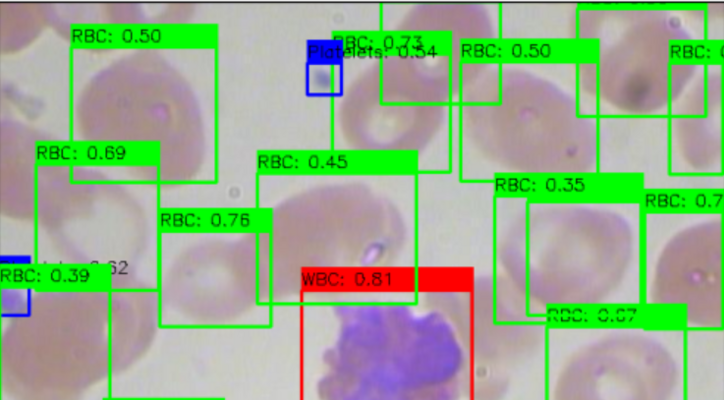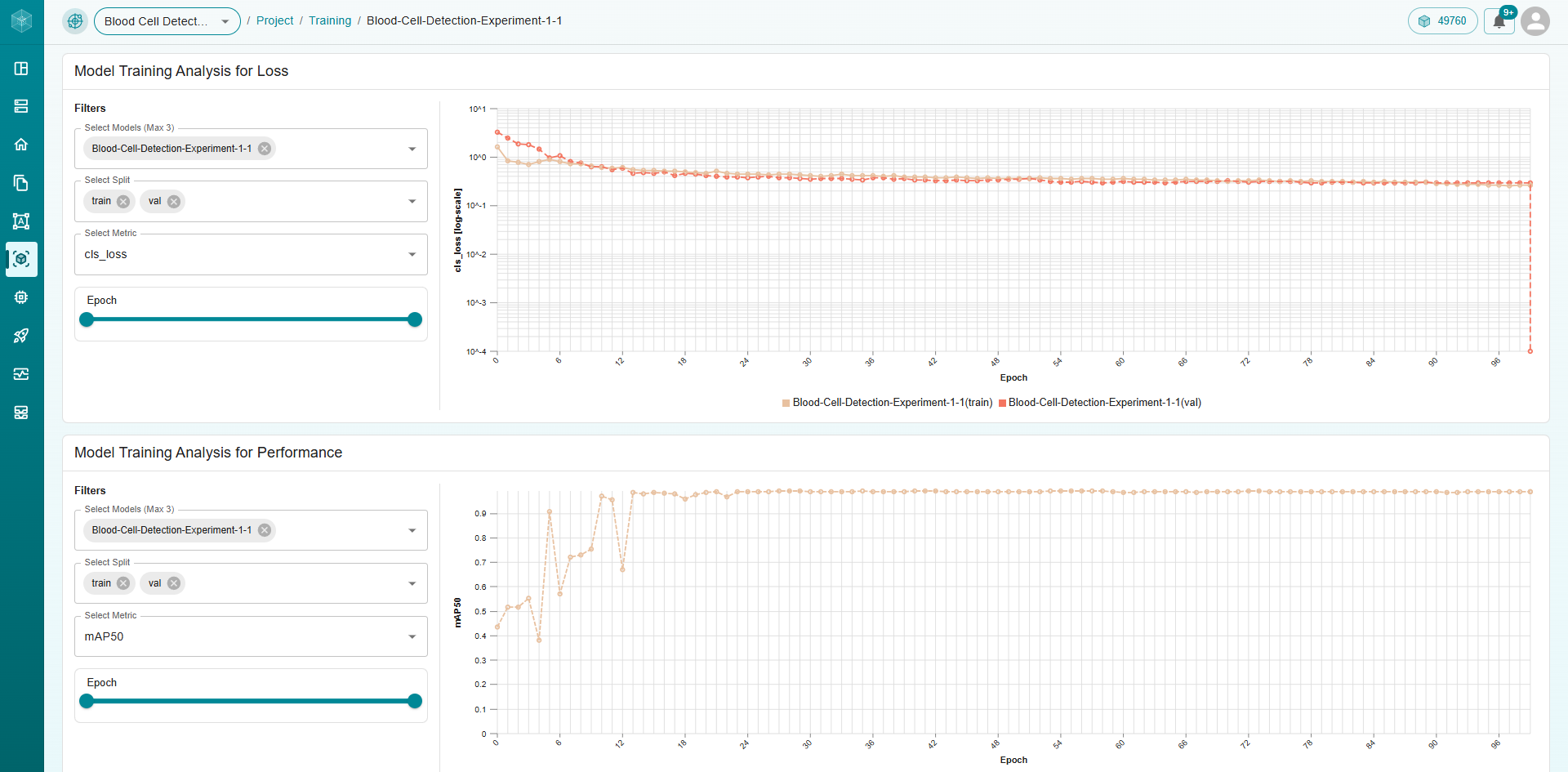Blood Cell Detection: Revolutionizing Healthcare with Computer Vision

Blood cell detection is a critical component in medical diagnostics, where identifying and counting various types of blood cells assists in diagnosing diseases, evaluating the immune system, and understanding overall patient health. Traditionally, blood cell analysis required trained laboratory professionals to examine samples under a microscope, but with advancements in artificial intelligence (AI) and computer vision, automated blood cell detection systems are transforming this process.
This blog explores the importance of blood cell detection, how AI technology works in this use case, and the tangible benefits it brings to healthcare.
1. Why Blood Cell Detection Matters
Blood cell analysis is a primary diagnostic tool for diseases ranging from anemia and infections to leukemia and other hematologic conditions. Key types of blood cells include:
Red Blood Cells (RBCs): Carry oxygen throughout the body and are indicators of oxygen-carrying capacity and overall health.
White Blood Cells (WBCs): Part of the immune system, with abnormal counts often signaling infections or immune disorders.
Platelets: Help with blood clotting, and irregular counts can indicate bleeding disorders.
Analyzing these cells’ morphology (shape and size) and count allows doctors to make crucial diagnoses quickly and accurately.
2. Benefits of AI in Blood Cell Detection
AI-driven blood cell detection offers several advantages:
Speed: Automated systems can process images in seconds, allowing for rapid diagnostics and enabling faster decision-making, especially in emergency situations.
Accuracy and Consistency: By minimizing human error, AI provides more consistent results, making it easier to track and monitor patient health.
Cost-Efficiency: Automated systems can perform high-volume testing, reducing the need for extensive manual labor and lowering overall costs for healthcare providers.
Remote Diagnostics: With AI, blood cell detection can be done remotely, bringing diagnostic services to areas with limited access to medical facilities.
3. Implementing Blood Cell Detection with Matrice
Dataset Preparation
Model Training
Model Evaluation
Model Inference
Model Deployment
Dataset Preparation
This dataset contains annotated red blood cells(RBC) and white blood cells(WBC) from peripheral blood smear taken from a light microscope. Images are collected from peripheral blood smear slides on a light microscope with high magnification and resolution. It contains 100 annotated images with labeled RBC as 2237and WBC as 103. Every image contains RGB channels and also is 256 pixels in both height and width.
Model Training
The model was trained using the following experiment parameters:
Parameter |
Value |
Description |
|---|---|---|
Model |
YOLOv8m |
YOLOv8 Medium variant - balances accuracy and speed |
Batch Size |
4 |
Number of samples processed in each training iteration |
Cosine LR |
True |
Uses cosine learning rate scheduling for better convergence |
Epochs |
100 |
Number of complete passes through the training dataset |
Learning Rate |
0.001 |
Initial learning rate for model optimization |
Momentum |
0.95 |
Momentum coefficient for SGD optimizer |
Optimizer |
Auto |
Automatically selects optimal optimizer based on model |
Primary Metric |
mAP50 |
Mean Average Precision at IoU threshold of 0.5 |
Weight Decay |
0.0005 |
L2 regularization factor to prevent overfitting |
Model training graph from Matrice platform

Model Evaluation
Once training was complete, we evaluated the model using key performance metrics to ensure its effectiveness:
mAP@50 (Mean Average Precision at IoU 50): Measures the model’s precision across various Intersection over Union (IoU) thresholds, crucial for object detection accuracy.
Precision: Indicates the proportion of correctly identified weeds out of all detections, reflecting the model’s accuracy.
Recall: Measures the model’s ability to correctly identify all instances of weeds in the dataset, ensuring thorough coverage.
Fitness: Measures the model’s overall performance, combining precision and recall.
Validation Results:
Metric |
All Categories |
RBC |
WBC |
|---|---|---|---|
Precision |
0.968 |
0.953 |
0.983 |
Recall |
0.963 |
0.926 |
1.000 |
F1 Score |
- |
0.939 |
0.991 |
AP/mAP |
- |
0.857 |
0.910 |
mAP50 |
0.990 |
- |
- |
mAP50-95 |
0.883 |
- |
- |
Fitness |
0.894 |
- |
- |
Test Results:
Metric |
All Categories |
RBC |
WBC |
|---|---|---|---|
Precision |
0.981 |
0.961 |
1.000 |
Recall |
0.933 |
0.959 |
0.907 |
F1 Score |
- |
0.960 |
0.951 |
AP/mAP |
- |
0.854 |
0.844 |
mAP50 |
0.953 |
- |
- |
mAP50-95 |
0.849 |
- |
- |
Fitness |
0.859 |
- |
- |
These metrics validate the model’s strong performance across both blood cell categories, with particularly high precision in detecting both RBCs (0.961) and WBCs (1.000). The model shows good balance between precision and recall, as reflected in the F1 scores (0.960 for RBCs and 0.951 for WBCs), while maintaining strong mAP50 (0.953) and mAP50-95 (0.849) scores across all categories. These results indicate the model will perform reliably in real-world blood cell detection scenarios.
Model Inference Optimization
A unique feature of our platform is the ability to export trained models to a variety of formats. For this use case, the model can be exported from PyTorch (.pt) format to formats like ONNX, TensorRT, and OpenVINO. This is particularly valuable for on-the-edge deployments, such as roadside cameras, where processing power may be limited.
By offering flexibility in model format, we ensure that models can be deployed in real-time settings without requiring extensive computational resources.
Model Deployment
Once the model is trained and optimized, deploying it is seamless with Matrice. Our platform supports real-time inference and allows integration via APIs for use in various applications.
You can use our pre-built API integration code for various programming languages, making it easy to computer vision functionality into web services, mobile apps, or custom applications.
4. Real-World Applications and Impact
AI-powered blood cell detection is being applied in various fields:
Telemedicine: Patients in rural or remote areas can send blood samples to centralized labs, where AI systems can quickly analyze and share results with healthcare professionals.
Oncology: Detecting abnormal WBC counts aids in diagnosing and monitoring cancers like leukemia.
Infectious Disease Monitoring: Blood cell detection helps track immune response, particularly in diseases that cause significant immune system activity.
Routine Health Check-Ups: AI can provide quicker diagnostics during regular check-ups, offering early detection and intervention for potential health issues.
Conclusion
Blood cell detection powered by AI is proving transformative in modern healthcare. By improving the speed, accuracy, and accessibility of blood cell analysis, AI is helping healthcare providers offer better care, leading to more timely diagnoses and improved patient outcomes. As AI technology continues to evolve, the future of blood cell detection—and healthcare as a whole—looks promising, with innovations that will further enhance medical diagnostics and patient care.
Think CV, Think Matrice
Experience 40% faster deployment and slash development costs by 80%